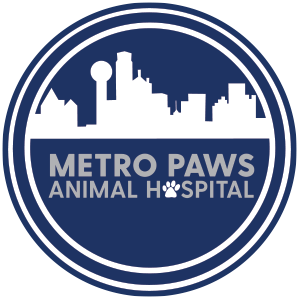GDV (Gastric Dilatation and Volvulus) and Preventative Gastropexy
— By Dr. Anna Adams, DVM —
We are lucky to have many incredible preventive veterinary medicine options to keep your pets as happy and healthy as possible for as long as possible. These include vaccinations, heartworm prevention, and routine bloodwork. But did you know that there are even surgical procedures that can be performed to prevent potentially deadly conditions from occurring in dogs and cats? This article will focus on one such procedure, called a gastropexy, which can prevent the dangerous condition known as gastric dilatation and volvulus (GDV).
What is a GDV (Gastric Dilation and Volvulus)?
GDV is a condition that occurs when the stomach of a dog – usually “deep-chested” breeds, like Great Danes, German Shepherds, Weimaraners, and Saint Bernards – becomes distended with gas and fluid (“bloat”) and eventually rotates on itself. As a result, compression of major abdominal vessels occurs. This quickly leads to compromise in blood flow to the abdominal organs and general cardiovascular shock. Within a matter of hours, a dog can become severely ill from GDV and is in significant risk of passing away even with medical and surgical intervention. GDV patients must be hospitalized and taken to surgery as quickly as possible to give them the best chance of survival, and to lower the risk of long term secondary conditions from occurring.
What are the symptoms of GDV?
Generalized anxiety, panting, abdominal bloating and pain, and “retching” (attempting to vomit without producing any) are the most seen symptoms that indicate a GDV may have occurred. If your pet is showing any of these symptoms – especially if they are a high-risk breed – they should be seen by a veterinarian right away as this condition is a life-threatening emergency. They will be assessed quickly, and x-rays of their abdomen will be taken to assess for GDV. This condition can usually be confirmed on x-rays and patients will be rushed to surgery as soon as possible. If left untreated, GDV will result in death.
What can be done to prevent GDV?
There have been many studies to assess risk factors of GDV and to try to determine ways to avoid it. The bottom line is that few studies have shown consistent correlations between any preventative strategies and reduced risk of GDV other than one: gastropexy. This is a surgical procedure that is often performed at the time of a patient’s spay or neuter that involves carefully attaching the outer wall of the stomach to the inner lining of the abdominal cavity, essentially “tacking” it in place so that it is highly unlikely to rotate, even if distended with gas. This procedure comes with a low risk of complications, and recovery time is unchanged from a typical spay or neuter. The gastropexy can be performed from the same abdominal incision as a spay in most large-breed dogs, and a special type of gastropexy can be performed from a separate, smaller incision between the ribs of male dogs who are having a neuter procedure. We recommend waiting to perform this procedure until pets are at least 1-2 years of age to ensure that they are fully grown before “tacking” the stomach, but gastropexy can be performed in any adult dog of any age. This preventative tacking procedure has a reported success rate of approximately 90%.
If your dog ever does develop a GDV and is rushed to surgery, the stomach will be flipped back into its normal position, and a gastropexy will be performed to prevent it from happening again.
Reach Out Today!
If you are interested in discussing a preventative gastropexy, please contact us here at Metro Paws Animal Hospital so we can consult with you regarding the best options for your pet! Preventative medicine is the best medicine to keep your pet happy and healthy for many years.
Contact us today for any questions or concerns.
